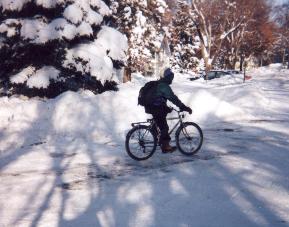 |
RECORD SNOWFALL in UPPER MIDWEST- DEC 2000 |
| Bob Rabin1,2 and Scott Bachmeier2
NOAA/National Severe Storms Laboratory, Norman, OK1 Cooperative Institute for Meteorological Satellite Studies, University of Wisconsin-Madison2 |
|
 |
RECORD SNOWFALL in UPPER MIDWEST- DEC 2000 |
| Bob Rabin1,2 and Scott Bachmeier2
NOAA/National Severe Storms Laboratory, Norman, OK1 Cooperative Institute for Meteorological Satellite Studies, University of Wisconsin-Madison2 |
|
For example, the mean temperature in Madison was 11.2 F as compared to the December average of 21.7 F. This was 0.4 F above the record low of 10.8 F.
The temperature was subfreezing continuously except for 2 brief periods on the 3rd and 4th when high temperatures reached 34 and 35 F respectively.
The mean minimum temperature was 2.0 F. The temperature fell below zero (-18 C) on 13 days with -21 F (-29.5 C) the coldest on the 25th.
Waterloo IA set
a monthly minimum record with -29 F on 25 December..
Measurable snow fell on 20 days giving a record total of 35" for the month.
The heaviest was 8.2" on the 18th, followed by 5.0" on the 11th, 4.6" on the 20th.
Total liquid
equivalent for the month was only 1.39" giving an average snow/liquid ratio
of almost 30 to 1.
Most snowfall
occured when the temperature was between 5-15 F. In some cases the snow/liquid
ratio was as high as 40 to 1.
The highest
Madison snow depth of 17" tied for the greatest December snow depth.
Milwaukee:
Milwaukee set a new snowfall record of 49.5" in December. This broke the previous record of 27.9" by almost 22"!
Snowfall
in Milwaukee was occasionally enhanced by northeasterly flow over Lake
Michigan.
The 13.6"
on the 11th was the greatest December single-day snowfall
There was as much as 32" of snow on the ground at MKE late in the month.
Climate
data from Wisconsin are available from the NWS MKE
(Milwaukee/Sullivan) Web page.
Iowa:
By the 21st, the average snowfall from all stations across the state was 19.8" - already a new record for December
Snow
depth reached 31" across northeast Iowa (29 December at Tripoli).
Other record Midwest snowfall for December:
Marquette
MI
89.5" *
Grand
Rapids MI
59.2 " *
South
Bend IN
44.6 "
Saginaw
MI
40.3 "
Dubuque
IA
37.6"
Rochester
MN
35.3" *
Waterloo
IA
34.0"
Rockford
IL
30.1" *
Green
Bay WI
28.9"
Des Moines
IA
26.9"
Springfield
MO
18.0"
Tulsa,
OK
11.4"
Oklahoma
City OK
8.2" (.8" short of record)
* - record snowfall for any month (see link from NWS
Central Region)